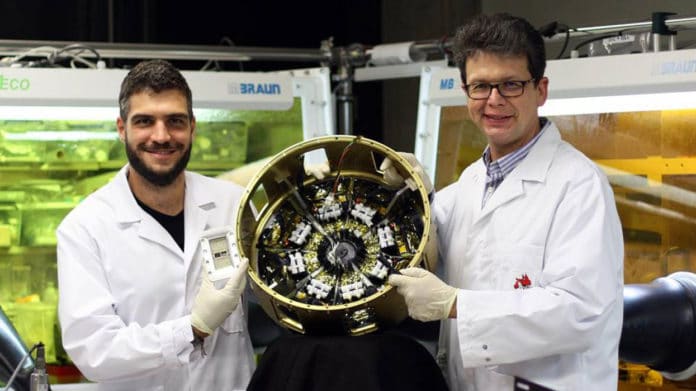The Sun is the main energy source for satellites, so all satellites have solar panel arrays mounted on them. But conventional high-performance cells reach up to three watts of electricity per gram. As a solution, Scientists from the Technical University of Munich (TUM) and the German Aerospace Center (DLR) thinks that perovskite and organic hybrid cells could provide up to ten times that amount.
Peter Müller-Buschbaum, Professor of Functional Materials at the TUM Department of Physics, said, “Perovskite and organic solar cells are promising options for future generations of solar cells.”
“The best perovskite solar cells currently achieve efficiency levels of 25 percent. These thin solar cells, less than one micrometer thick, applied to the ultra-thin, flexible synthetic sheet, are extremely lightweight. They can, therefore, produce nearly 30 watts per gram.”
Production of silicon solar cells requires high temperatures and elaborate processes. Perovskite cells and organic semiconductors, then again, can be produced at room temperature from the solution.
The lead author Lennart Reb said, “These organic solutions are very easy to process. Thus the technologies open up new fields of application in which conventional solar cells were too unwieldy or too heavy – and that also applies far beyond the aerospace sector.”
Scientists experimented with perovskite and organic solar cells onboard a short rocket flight as part of the MAPHEUS 8 program at the European Space and Sounding Rocket Range in Kiruna, Sweden, reaching satellite altitudes for the first time. During the flight, the electrical characterization demonstrated that the solar cells matched their performance expectations, highlighting their potential for the application in space.
Professor Andreas Meyer, co-author, and Head of the DLR Institute of Materials Physics in Space said, “Our MAPHEUS program allows us rapidly to implement experiments in a zero-gravity environment, offering exciting research findings. This time it went particularly quick: it took us less than a year to progress from the initial idea to the solar cells’ maiden flight as part of the MAPHEUS 8 program.”
Professor Müller-Buschbaum said, “Electrical measurements during the flight and the evaluation after recovery of the rocket showed that perovskite and organic solar cells can achieve could potential in terms of expected performance in orbit height. Our measurements are therefore of great scientific value.”
Reb said, “The solar cells also generated electrical energy under the diffuse incidence of light. Cells turned away from the sunlight, which received only sparse lighting exclusively from the earth during the flight, still supplied electricity.”
Due to their much thinner thickness, the new solar cells could also be used in much dimmer light, such as missions to the outer solar system on which the Sun is too weak for conventional space solar cells.
According to DLR material scientist Andreas Meyer, “it would not be the first time that innovations are first established as space technologies but go on to be used around the world in other sectors. One reason for this is probably the very strict requirements that space places on all technical components.”
Journal Reference:
- Lennart K. Reb et al. Perovskite and Organic Solar Cells on a Rocket Flight. Joule (2020), DOI: 10.1016/j.joule.2020.07.004
